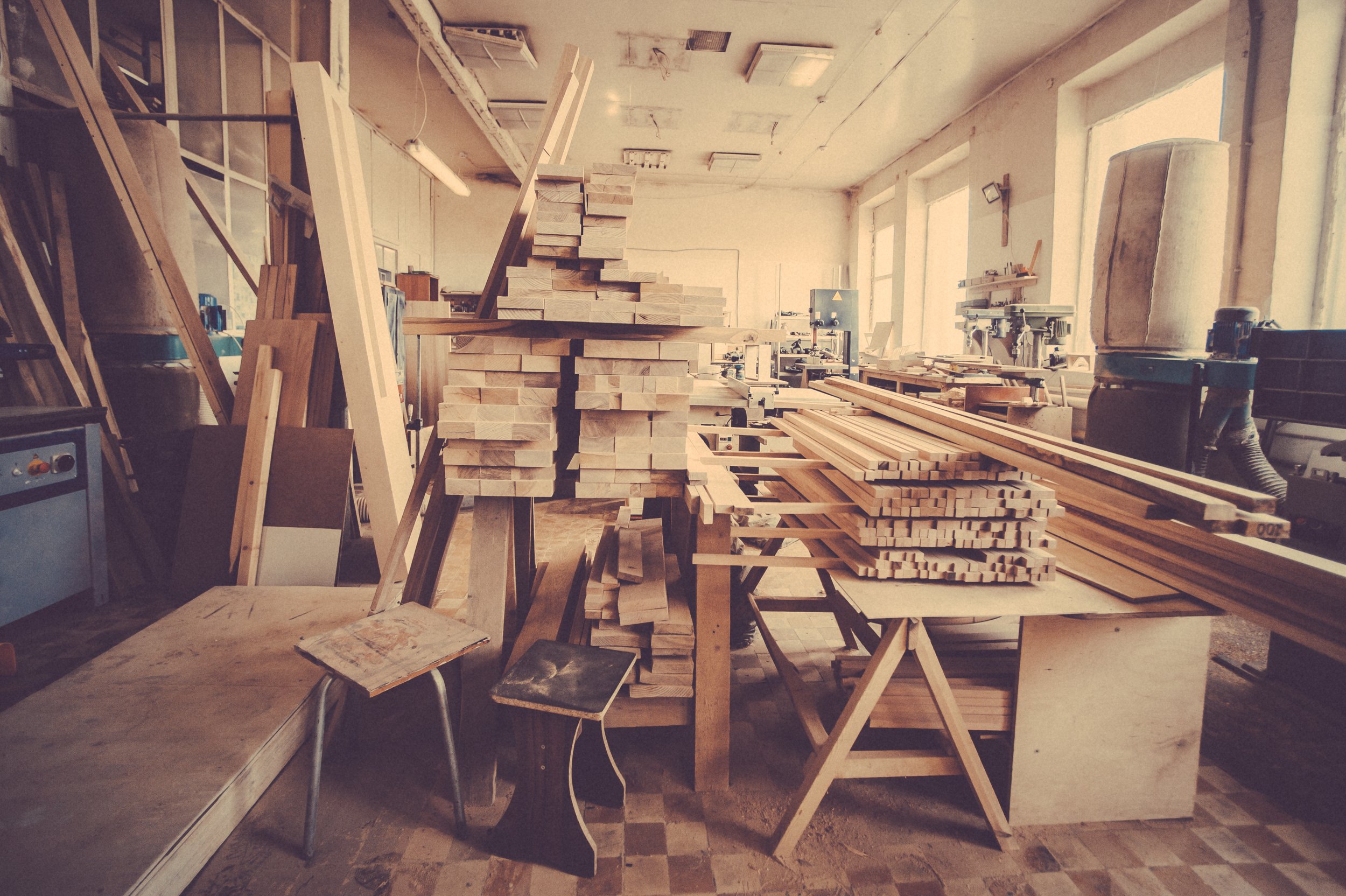Understanding Wood Grades
Have you ever been to a furniture gallery and been enchanted by the natural beauty of the handcrafted pieces and admired the details like the wood grain patterns, the contrasting colors that complement one another's beauty, or how the various elements seem to blend to produce one masterpiece? Well, you're not the only one because we've found ourselves in that position several times. Yes, you could say that we are "wood nerds" which is why we produced this article. Since we are artists, we feel that it is important to point out the differences in the different grades of wood.
All building projects, from a commercial or residential decor to an at-home DIY project, begin with raw materials, or in this case lumber. Everything from structural strength to best use to appearance will be determined by the quality of lumber you choose for your project. This guide will help you choose the right lumber grade for all your projects, whether you're starting a large commercial construction project or starting out in home improvement.
How Do Hardwoods and Softwoods Differ?
To begin understanding the different grades of lumber, it is first necessary to understand that all lumber can be divided into hardwoods and softwoods. Softwood refers to any wood that comes from an evergreen tree. Softwood trees grow more rapidly and are more abundant than hardwood trees, so they tend to be lighter, less dense, and more affordable. Softwood is ideal for construction because it features a straighter grain, ensuring adequate strength for building components and framing.
Hardwood is obtained from deciduous trees, those that lose their leaves in the fall. Hardwood trees have more intricate grain patterns, making them the preferred choice for woodworking projects and artistic projects. As hardwoods are formed more slowly than softwoods, they are denser, therefore more durable and stronger. Hardwood is commonly used in construction applications where longevity and appearance are both key factors, like flooring, cabinetry, furniture, and more. Due to its scarcity, hardwood lumber tends to be more expensive than softwood.
How Does Lumber Grading Work?
Once we understand the differences between hardwood and softwood, we can move on to the specifics of lumber grading. A lumber grade is a standard way of measuring the quality of a wood or piece of lumber. There are separate grading scales for softwoods and hardwoods. Generally, softwood lumber comes in a wider variety of grades depending on the intended use. Lumber grades are important for determining what you can expect from a particular piece of wood, as well as how each piece of wood can be used for safe, secure construction. We will begin our discussion of softwood lumber grades with that in mind.
Softwood Lumber Grades
Based on its intended use, softwood lumber grades are divided into categories. The versatility of softwood enables it to be used in almost any application, from framing and supporting a house to paneling it. Different categories of softwood lumber grades help make it easier to select the right grade for your application, ensuring the strength and quality of your construction.
Non-Stressed Lumber Grades
The first category of softwood lumber is primarily used in building, for applications that do not require a great deal of structural support, but aren't highly visible. This lumber is commonly used for siding, shelving, and paneling, where it will usually be painted over, as well as for subflooring and sheathing, where its appearance is not important. According to the number of defects in the wood, non-stressed lumber can be categorized into five different grades.
No 1.
Often called a "construction grade," No.1 lumber might have some knots, but is otherwise relatively defect-free and easy to paint, making it ideal for shelving, siding, or paneling.
No. 2
A "standard" grade, No. 2 softwood accepts paint well, but contains many larger knots. It is an inexpensive option that will still work well if you plan to paint it.
No. 3
It is commonly used for utility applications, such as subfloors and sheathing, since it is considered a "utility" grade. The surface won't accept paint as well as No. 1 or 2, and there may be knotholes and splits. It is a great option for unseen building applications.
No. 4
Economy grade softwood lumber No. 4 contains large areas of waste wood, along with splits, knotholes, and a variety of other defects. Sheathing, subflooring, and creating concrete forms are ideal uses for this wood, since it won't accept paint.
No. 5
No. 5 softwood is also referred to as an "economy" grade because it has the most waste areas and defects. Like No. 4, it's used to make forms, molds and models where it won't be seen.
Grades of Appearance Lumber
Softwood lumber used for applications where it will be visible, such as furniture construction, is known as appearance lumber. As a result, the appearance of the wood is important. It is broken down into two categories: Select and Common, each of which can be broken down into different grades.
Select Appearance Lumber: Grades A-D
For exposed applications where looks matter, select appearance lumber is the best choice. It comes in four grades, A through D.
Grade A
Lumber of grade A appearance has no visible defects such as knots or splits.
Grade B
Despite a few visible defects, there are no obvious knots on this grade.
Grade C
One side might be free of defects, while the other may have a few small knots.
Grade D
Pin knots, blemishes, and other imperfections are present in this lumber but they don't affect its quality.
Common Appearance Lumber
There are two types of common appearance lumber. The common appearance lumber has more defects and knots than select lumber, but some prefer it for furniture and other visible woodworking applications because it has more character.
No. 1 Common
A wood with enough knots to give it a "knotty" appearance, such as knotty pine. Knots are present, but they are small and tight, making them unlikely to come undone.
No. 2 Common
Chosen for the appearance of the knots like Common No. 1, but tight knots are slightly larger.
Stress-Graded Lumber
Any softwood lumber that has been graded to support weight is considered stress-graded. Stress-graded lumber is graded based on its tensile strength and is used primarily for non-visible structural applications, such as beams, posts, studs, rafters, and joists. There are four main categories of stress-graded lumber: structural light framing, light framing, studs, and structural joists & planks, each with its own grade.
Structural Light Framing
Lumber between 2′′ x 2′′ and 4′′ x 4′′ is used for structural light framing. Lumber graded No. 1-3 is structural light framing lumber, with defects increasing with the number. Engineered wood trusses are commonly constructed using light structural framing lumber.
Light Framing
Despite being classified in the same size range as structural light framing, light framing lumber has slightly different applications. Light framing grade lumber is best suited for applications where the lumber won't have to support as much load, such as walls, windowsills, doors, plates, and blocking. There are three grades of light framing lumber: construction, standard, and utility.
Stud
Stud lumber is defined as lumber with dimensions from 2"x2" to 4"x18". A load-bearing wall application requires lumber graded for vertical use only.
Structural Joists and Planks
The softwood lumber grade for structural lumber, or structural joists and planks, is the largest grade of lumber. Timber used for structural joists and planks must be between 2 inches by 5 inches and 4 inches by 18 inches. A few common applications for lumber in this grade include floor and ceiling joists, rafters, headers, and trusses. No. 3 is the utility or economy class of structural joists and planks, with Select structural being the highest grade.
Hardwood Lumber Grades
There is only one set of grades for hardwood lumber, unlike softwood lumber. This makes understanding them a bit easier. All hardwood lumber grades are graded based on the appearance of the wood, since the wood is mostly exposed. Size is the other factor that contributes to hardwood lumber grades. When compared to lower grades, higher grades have a greater percentage of attractive material that can be used. Let's take a look at how hardwood lumber grades are categorized:
Firsts and Second Lumber Grades (FAS)
FAS is the most expensive and highest quality lumber, characterized by boards longer than 8 feet and wider than 6 inches. The board must yield 83-1/3% clear face cuttings on both sides in order to qualify as FAS grade lumber. Minimum cutting size is 3" wide by 7' long or 4" wide by 5' long.
FAS One Face (F1F)
A F1F board must meet the same requirements as FAS lumber, but only on one face. The less attractive face can meet the lower requirements of the number 1 Common grade. As with FAS lumber, this lumber can still be used for applications like long moldings and furniture.
Selects (SEL)
The selected grade of lumber must meet the same requirements as F1F, but with a smaller minimum board size. Lumber deemed to be SEL must be 4" and wider and at least 6' long.
No. 1 Common
It is frequently used for furniture and kitchen cabinets, as well as plank and strip flooring. This type of lumber is sometimes referred to as cabinet grade. No. 1 Common lumber needs to be at least 3" wide x 4' long, with a clear face yield of at least 66-2/3%, but not as high as FAS minimum yield.
No. 2A & 2B Common
No. 2A and 2B Common grade lumber is ideal for paneling and flooring applications, requiring at least 50% clear face cuttings on boards at least 3 inches wide with a length of 2 feet or more.
No. 3A & 3B Common
A 3A or 3B hardwood lumber grade must be at least 3′′ wide and 4′ long to be considered "economy." 3A Common must yield 33-⅓ percent clear face cuttings, while 3B Common can yield 25 percent clear face cuttings. This lumber grade is best used for rough utility applications such as fencing, pallets, etc.
Lumber Grades Explained
The grading of lumber is based on a variety of factors, but they all help you determine which type is best suited to the task at hand. If the wood you use doesn’t need to be visible, you can choose a lower grade and save money. When exposed to the eye, a higher grade of lumber will guarantee structural soundness and an attractive finish. Understanding both softwood and hardwood lumber grades a little better will help you decide which type of lumber to use for your next project or purchase.


